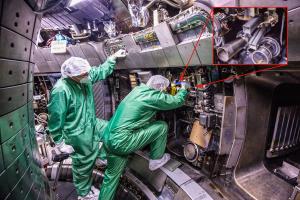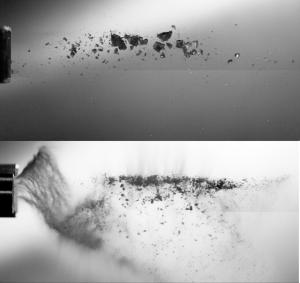Hail showers in ASDEX Upgrade for ITER disruption mitigation
Just before the 2021 Christmas holiday break, the team at the ASDEX Upgrade tokamak successfully fired frozen deuterium pellet fragments into a plasma as part of a global effort within the fusion institutes of the ITER Members to explore the physics of disruption mitigation for ITER based on shattered pellet injection technology.
The shattered pellet injection technique works by forming cryogenic pellets and firing them at high speeds towards a shattering section, where they are disintegrated into showers of small fragments which are sprayed into the plasma chamber. These tiny iced particles penetrate into the plasma where they evaporate and deliver the quantity and species of material required to ensure the mitigation process. The disruption mitigation system foreseen for ITER will use the injection of hydrogen, neon and mixtures thereof to raise the plasma particle density before it disrupts. This avoids the generation of high-energy runaway electrons during the plasma current quench phase of the disruption and converts a large fraction of the plasma energy into photonic radiation, which very significantly reduces the thermal and electromagnetic loads on plasma-facing components and the confinement chamber.
To study the relationship between the pellet fragment properties and the associated rise in plasma density, in May 2020 the ITER Organization launched a project together with the Max Planck Institute for Plasma Physics (IPP), in Garching, Germany, to install a shattered pellet injection system on the ASDEX Upgrade tokamak. Michael Lehnen, Leader of the Disruption Mitigation System Task Force, describes this specially designed system and the capabilities it will offer as key in "closing the gap in our experimental program by providing unique information on the impact of different pellet shatter sizes and velocities on the mitigation process."
_GAo_//static.iter.org/com/animation/figure1.gif*350*right_GAx_ Following an intensive period of assembly, commissioning, and laboratory characterization, fragmented pellets were injected by the shattered pellet injection system for the first time on 14 December 2021 into an ASDEX Upgrade H-mode plasma. The movie on the right shows a dual injection, with a first plume of fragments entering on the low magnetic field side of the vessel (right part of the picture) followed by a second injection with a delay of 20 ms. The gas from the ablated fragments is ionized and forms the radiating streamers which are visible in both the toroidal and poloidal directions.
The heart of the ASDEX Upgrade shattered pellet injection system is a state-of-the-art, three-barrel gun injector designed and built by PELIN LLC., St. Petersburg, Russia. The injector incorporates many unique features allowing the control of pellet size and velocity. The pellets from the three barrels can be fired independently against the in-vessel shatter heads, whose geometries have been chosen to generate different fragment size distributions, spatial extents of the fragment plume and injection durations.
_GAo_//static.iter.org/com/animation/figure3a.gif*350*left_GAx_ Before its installation, the shattered pellet injection system was commissioned and underwent extensive testing in a laboratory at IPP. The pandemic has posed additional challenges, requiring Igor Vinyar, the director of PELIN, and his team to participate mainly remotely in the commissioning work. "The start of the ASDEX Upgrade shattered pellet injection project coincided with the onset of the COVID-19 pandemic. The severe restrictions and uncertainties, the halt of travel, as well as the disruption of the complex global supply chains necessary to procure or manufacture the thousands of unique components have posed significant challenges," says Gergely Papp, leader of this project at IPP. "Despite the hardships, thanks to the expertise and dedication of the teams at IPP, PELIN and ITER the first pellets could be fired into ASDEX Upgrade 18 months after the contract signature."
To study in detail the impact of the injected material on a plasma disruption, the shattered pellet injection installation at ASDEX Upgrade has been accompanied by the upgrade of several essential diagnostics. The non-axisymmetric plasma radiation will be measured with bolometers using AXUV diodes and foil cameras, located at six different toroidal and poloidal positions on the tokamak. The arrival of the fragments can be observed with three high-speed cameras viewing the injection location toroidally, horizontally and vertically. This diagnostics upgrade for shattered pellet injection project was one of the largest of its kind for the ASDEX Upgrade.
The shattered pellet injection system and diagnostics will be put to work during the coming months in a series of experiments conducted by the ITER Disruption Mitigation System Task Force together with IPP and the EUROfusion consortium. These ASDEX Upgrade shattered pellet injection tests are part of a broad experimental effort within the Task Force, which is supported by the domestic programs of the ITER Members. "Developing a credible design solution for the ITER disruption mitigation system requires the testing of all key injection parameters on actual tokamak experiments," says Lehnen. "Together with the extensive modelling activities in the Task Force, I am confident that we will have a good basis to provide our engineers with the information they need to optimize the design of the ITER disruption mitigation system."



